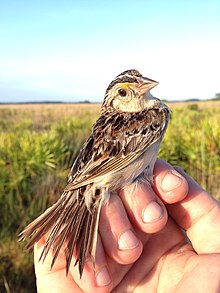An emergency effort to prevent
extinction of Florida grasshopper sparrows, found only in Central Florida,
includes attempts to breed them in captivity. The first four birds hatched this
week.
Contact
Reporter Orlando Sentinel
Florida grasshopper sparrow
chicks defy long odds
One of the nation's most
endangered birds, a rare sparrow found only Central Florida, took a step away
from potential extinction this week with the unprecedented hatching of four chicks
in captivity.
"It's a historic
breakthrough," said Ken Warren of the U.S. Fish and Wildlife Service,
referring to the largely unexpected births of Florida grasshopper sparrows.
The parents were among three
males and four females taken as chicks last year from treeless prairies south
of Orlando, where only about 100 males have been tracked and the number of
secretive females remains unknown.
Federal approval to capture the
birds came after years of biologists agonizing over how to stop a plunge in the
bird's population for reasons still not explained.
The seven were taken to Rare
Species Conservatory Foundation in Palm Beach County, which specializes in
rearing birds and animals on the edge of extinction.
"This is a very small group
to be starting out with, and to be able to find a compatible pair of birds that
are unrelated and happen to get along and happen to build a nest and happen to
successfully hatch chicks – these are really long odds," said Paul Reillo,
foundation director.
Reillo said he had expected many
false starts instead of success in the pair's first nesting attempt.
He said the parents began to show
signs of "sexual proclivity" early this spring and laid the first egg
on April 26.
The first hatching was early
Monday morning, with the others later in the morning, that afternoon and
Tuesday morning.
Reillo estimated that each chick
weighs less than 2 grams, or less than half of the weight of a nickel.

No comments:
Post a Comment